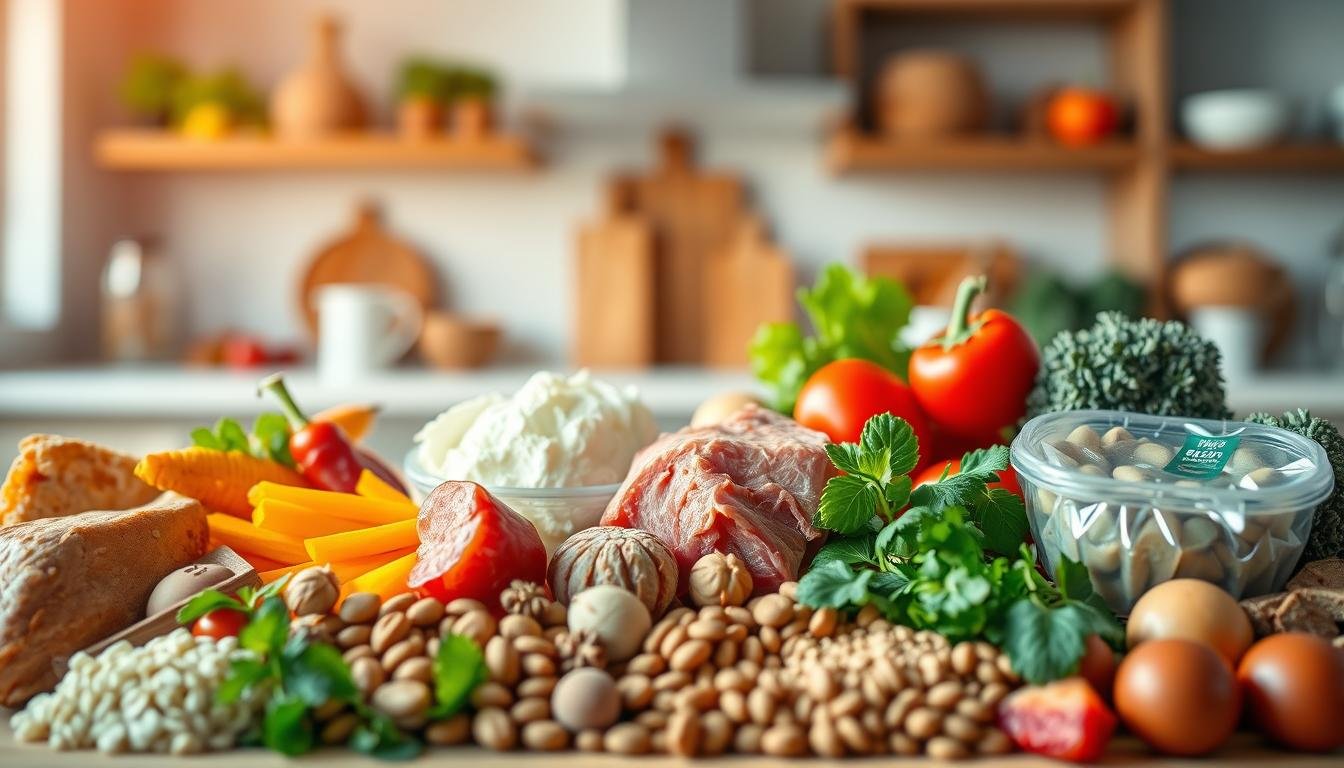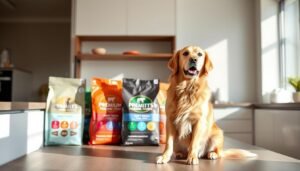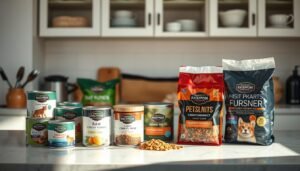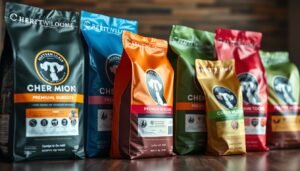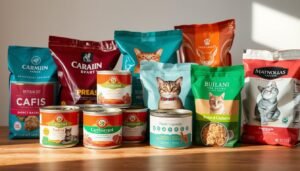I love my dog and always think about what’s best for them. At a pet expo, I heard about grain free dog food. A pet nutritionist talked about how it can help dogs feel better.
They said dogs might have better digestion and more energy. This made me wonder if it could help my dog. I wanted to know if grain-free food was good for my dog.
I learned it’s important to know the good and bad of grain-free food. And to talk to my vet for advice. This way, I can make the best choice for my dog.
Key Takeaways
- Grain free dog food may cater to specific dietary needs.
- Improved digestion and energy levels can be possible benefits.
- Consulting with a veterinarian is key when changing diets.
- Understanding ingredient labels helps make good choices.
- Not all dogs need a grain-free diet.
What is Grain Free Dog Food?
Grain free dog food is popular among pet owners. It doesn’t have common grains like wheat or corn. Instead, it focuses on quality and natural ingredients.
Definition and Ingredients
Grain free dog food doesn’t have grains. It uses protein and healthy carbs like sweet potatoes. These foods are good for dogs and make them feel better.
Popular Grain Alternatives
Knowing what’s in grain free dog food is helpful. Here’s a table of popular alternatives and their benefits:
| Ingredient | Benefits |
|---|---|
| Sweet Potatoes | High in fiber and vitamins, great for digestion |
| Peas | Rich in protein and antioxidants |
| Lentils | Excellent source of protein and iron |
| Chickpeas | Loaded with fiber and promote heart health |
| Various Vegetables | Provide essential vitamins and minerals |
Why Consider Grain Free Dog Food?
Grain-free dog food is a good choice for many pet owners. It might help dogs with health issues related to food. Many owners want to know if it can help with problems like upset stomachs or skin issues.
Health Benefits for Dogs
Switching to grain-free food has helped my dog’s health a lot. Dogs with grain allergies feel better and are more comfortable. Symptoms like itching and vomiting can be caused by grains in regular dog food.
Grain-free foods have special ingredients that are good for dogs. They help dogs with allergies and sensitivities without causing problems.
Common Allergies and Sensitivities
Grain-free diets help dogs with common allergies and sensitivities. Many dogs have gluten intolerance, which can be very bad for their health. By not eating grains, my dog’s digestion and energy have improved.
It’s important to pick a grain-free food that is balanced. There are good resources, like this guide, to help choose the right one. This ensures my dog gets the best food without harmful ingredients.
Nutritional Value of Grain Free Options
Looking at grain free dog food, we see two main things: protein and carbs. Knowing about these helps pick the best food for my dog.
Protein Sources
Grain free foods often use animal meats like chicken, beef, or fish. This meets a dog’s natural diet needs and gives them amino acids for muscles. Legumes like lentils and chickpeas also add protein, which is great for active dogs.
Carbohydrate Content
Grain free foods have less carbs than foods with grains. They use veggies and legumes instead, which are good for fiber and don’t raise blood sugar fast. This makes them good for dogs at risk of obesity or diabetes.
Potential Risks of Grain Free Dog Food
Exploring grain free dog food, I see some risks. Many pet owners like the benefits, but there are heart health worries.
Heart Health Concerns
The FDA is looking into grain free food and heart problems in dogs. They found a link to dilated cardiomyopathy (DCM). This makes the heart pump blood poorly.
Some breeds not usually at risk are getting heart problems. This makes people look closer at grain free food. I need to watch my dog for signs like tiredness or coughing.
Other Health Issues
Grain free diets can cause other health issues. Dogs might not get all the nutrients they need. This can make them sick.
Legumes in these diets can also upset their stomachs. It’s hard for my pet. Knowing these risks helps me choose the best food for my dog.
Understanding Dog Food Labels
Reading dog food labels can feel overwhelming at first. But, understanding the ingredients is key to choosing the right food for my dog. It’s important to know what I’m feeding my pet and to choose quality over marketing tricks.
When looking at premium grain free dog food, I look for ingredients that help my dog stay healthy. This means finding foods that offer a balanced diet.
How to Read Ingredients
Ingredient lists show the main parts of the food first. When picking grain free dog food, I look for high-protein sources like real meat, fish, or poultry. These should be the first items listed.
It’s also important to watch out for vague terms. “Meat meal” is not as good as specific meat sources. Reading labels carefully helps my dog get the best nutrition.
Looking for Quality Certifications
Quality certifications add an extra layer of safety. The Association of American Feed Control Officials (AAFCO) sets standards for food quality. Many premium grain free dog food brands follow these guidelines.
AAFCO certified foods meet my dog’s nutritional needs. These certifications show a commitment to safety and nutrition in dog care.
Choosing the Right Grain Free Food for My Dog
Choosing the right grain free dog food is important. It depends on my dog’s age, breed, how active it is, and any health issues. Knowing these things helps pick the best food for my dog.
Assessing My Dog’s Nutritional Needs
To make sure my dog eats well, I need to know what it needs. This includes:
- Age: Puppies, adults, and seniors all need different foods.
- Breed: Some breeds need special nutrients because of health issues.
- Activity Level: Active dogs need more protein and fat in their food.
- Health Issues: Dogs with allergies or sensitivities need special foods.
Consulting with My Veterinarian
Before changing my dog’s food, I talk to my vet. They can say if grain free food is good for my dog. They help make sure the food is right for my dog’s health and needs.
Popular Grain Free Dog Food Brands
Choosing the right grain free dog food is important. I look for brands known for quality and care for pets. Brands like Acana, Blue Buffalo, and Taste of the Wild are well-known. They offer different options for dogs’ needs.
When picking a brand, I consider the ingredients, what others say, and the brand’s reputation. This helps me find the best food for my dog.
Overview of Top Choices
Each brand has its own special features. Acana uses fresh, local ingredients for a top-notch meal. Blue Buffalo puts real meat first, with fruits and veggies too. Taste of the Wild goes back to dogs’ wild ancestors for a balanced diet.
Brand Reputation and Reviews
Brand reputation matters a lot. Acana is known for its quality and clear sources. Blue Buffalo has many happy customers who see health improvements. Taste of the Wild is loved for its taste and nutrients.
Thinking about these points helps me make a good choice.
| Brand | Key Features | Customer Ratings |
|---|---|---|
| Acana | Fresh, local ingredients; high meat content | 4.5/5 |
| Blue Buffalo | Real meat first; variety of flavors | 4.6/5 |
| Taste of the Wild | High-quality protein; grain free | 4.7/5 |
How to Transition My Dog to Grain Free Food
Switching to grain free dog food needs careful planning and patience. A slow change helps my dog’s stomach get used to it. This way, my dog can adjust well without getting sick.
By following a few steps, I can make the switch smoothly. I’ll watch how my dog reacts closely.
Steps for a Smooth Transition
- Start by mixing a small amount of the grain free dog food with the current food.
- Gradually increase the proportion of the new food over a period of 7-10 days.
- Observe my dog’s stool consistency and general behavior during the transition.
- Maintain hydration and consider giving smaller, more frequent meals.
- Consult grain free dog food reviews to find the best options for my dog.
Common Challenges I Might Face
During the transition, I might see changes in my dog’s appetite or stool. It’s key to stay calm and watch closely. This way, I can see if I need to make changes.
Knowing these possible problems helps me get ready for the change. It makes the transition easier for both of us.
Homemade Grain Free Dog Food Options
Making homemade grain free dog food is fun for me and my dog. It lets me pick the ingredients carefully. This way, I make sure my dog gets what they need to stay healthy.
I use natural ingredients in my dog’s meals. This helps keep them healthy. Here are some tasty recipes I can try, along with tips on what’s good for my dog.
Recipes I Can Try
- Chicken and Vegetable Medley: Cook chicken with carrots, peas, and sweet potatoes for a balanced meal.
- Beef and Quinoa Delight: Sauté ground beef with spinach and add cooked quinoa for a protein-rich dish.
- Turkey and Pumpkin Mix: Mix ground turkey with canned pumpkin and green beans for a nutritious meal.
Nutritional Considerations for Homemade Meals
When making homemade grain free dog food, I balance proteins, fats, and veggies. Each meal should match my dog’s needs and give them important vitamins and minerals. Here are some important things to remember:
| Nutrient | Recommended Amount | Sources |
|---|---|---|
| Proteins | 30-50% of diet | Chicken, beef, turkey, fish |
| Fats | 10-20% of diet | Fish oil, flaxseed oil |
| Vegetables | 20-50% of diet | Carrots, peas, spinach, sweet potatoes |
My Personal Experience with Grain Free Dog Food
Switching to grain free dog food changed my dog’s health and energy. I saw many benefits. His skin issues got better, and he was less itchy.
What I Noticed in My Dog’s Health
His digestion got better. He had firmer stools, which was easier for me. His energy levels went up too.
He became more playful and loved going for walks. He also had less gas. This made me feel good about his diet.
Tips for Other Dog Owners
If you’re thinking of switching to grain free, start slow. Quick changes can upset their stomach. Start adding the new food a little at a time.
Watch their health closely. Keep track of any changes in their coat, energy, or digestion. Always talk to your vet to make sure it’s right for your dog.
Be patient and enjoy the journey. You’ll see the benefits of grain free dog food for your furry friend.
Frequently Asked Questions About Grain Free Dog Food
Many dog owners wonder who can eat grain-free food. Some breeds like Bulldogs, Dachshunds, and Greyhounds do well on it. Dogs with allergies or sensitivities might also benefit.
But, not all dogs need grain-free food. It’s smart to talk to a vet first.
Some people worry that grain-free food costs more. Yes, it often does. But, the better ingredients might be worth it for your dog’s health.
Knowing the answers to these questions helps a lot. It makes choosing food for your dog easier. You can decide if the benefits are worth the cost.

